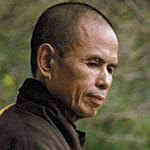When we look deeply we see that suffering and happiness inter-are, just as the mud and the lotus interpenetrate each other. A lotus can only grow in mud. If there were no mud, there would be no lotus flower. There’s a very close connection between suffering and happiness, just as there is between mud and lotus. Real happiness is possible when we have the right view of suffering and happiness. It’s the same as front and back, right and left. The right cannot exist without the left; the left cannot exist without the right. Happiness cannot exist without suffering.
Happiness is a kind of flower. If you look deeply into happiness, you see non-happiness elements, including suffering.
Happiness is made of non-happiness elements, just as the flower is made of non-flower elements. When you look at the flower, you see non-flower elements like sunlight, rain, earth—all of the elements that have come together to help the flower to manifest. If we were to remove any of those non-flower elements, there would no longer be a flower. Happiness is a kind of flower. If you look deeply into happiness, you see non-happiness elements, including suffering. Suffering plays a very important role in happiness.

